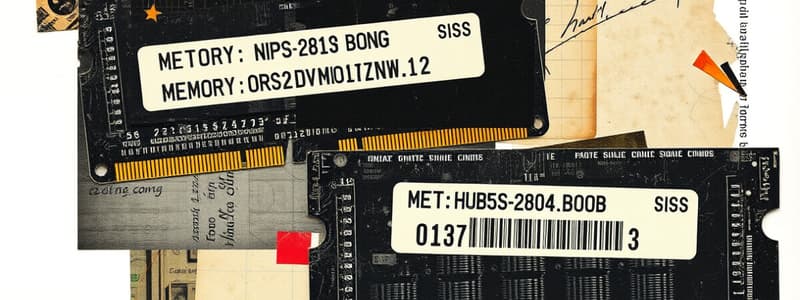Podcast
Questions and Answers
What is a bit?
What is a bit?
- A type of processor
- 0s and 1s, binary digits (correct)
- A program
- A memory unit
What are processors?
What are processors?
Circuits that execute a list of desired calculations (instructions).
Where are instructions stored?
Where are instructions stored?
Memory
What is memory?
What is memory?
Instructions operate on _________, which is also stored in _______________ locations as 0s and 1s.
Instructions operate on _________, which is also stored in _______________ locations as 0s and 1s.
Chef ( ) executes instructions of a recipe ( ), each instruction modifying ingredients ( ), with the recipe and ingredients kept on a nearby counter ( ).
Chef ( ) executes instructions of a recipe ( ), each instruction modifying ingredients ( ), with the recipe and ingredients kept on a nearby counter ( ).
What is a sequence of instructions?
What is a sequence of instructions?
What are machine instructions?
What are machine instructions?
What is an executable program?
What is an executable program?
What do assemblers/assembly language instructions do?
What do assemblers/assembly language instructions do?
When were high-level languages created?
When were high-level languages created?
What do high-level languages do?
What do high-level languages do?
What are compilers?
What are compilers?
To run a program on multiple processor types: the programmer must have the compiler generate multiple ____________.
To run a program on multiple processor types: the programmer must have the compiler generate multiple ____________.
How does Java run on different processor types?
How does Java run on different processor types?
Sometimes running things on a virtual processor makes execution __________.
Sometimes running things on a virtual processor makes execution __________.
What used to be a job title?
What used to be a job title?
What is software?
What is software?
What is hardware?
What is hardware?
What are input/output devices commonly called?
What are input/output devices commonly called?
What does a disk (hard drive) do?
What does a disk (hard drive) do?
What is non-volatile memory?
What is non-volatile memory?
What is flash storage?
What is flash storage?
What is RAM (random-access memory)?
What is RAM (random-access memory)?
One byte = ________.
One byte = ________.
What does the processor do?
What does the processor do?
What does BIOS stand for?
What does BIOS stand for?
What does the processor execute?
What does the processor execute?
What are processors also known as?
What are processors also known as?
What is cache memory?
What is cache memory?
What does a processor's clock do?
What does a processor's clock do?
How do programs actually run "simultaneously"?
How do programs actually run "simultaneously"?
What are transistors?
What are transistors?
What is Moore's Law?
What is Moore's Law?
What are cores?
What are cores?
When was the first C book written?
When was the first C book written?
Who wrote the first C book and where?
Who wrote the first C book and where?
What was the dominant programming language in the 80s and 90s?
What was the dominant programming language in the 80s and 90s?
When was the first book about C++ written?
When was the first book about C++ written?
Who created C++?
Who created C++?
What was different about C++?
What was different about C++?
When was Java first released to the public and from where?
When was Java first released to the public and from where?
Java is NOT...
Java is NOT...
A computer program consists of instructions that a computer...
A computer program consists of instructions that a computer...
What is code?
What is code?
What is a line?
What is a line?
What is main?
What is main?
What is a method?
What is a method?
What do { and } denote in programming?
What do { and } denote in programming?
What is a statement?
What is a statement?
Every program statement ends with...
Every program statement ends with...
What is the return statement?
What is the return statement?
What is a variable?
What is a variable?
What do print statements do?
What do print statements do?
What does println print?
What does println print?
What is a compiler?
What is a compiler?
What is a comment in programming?
What is a comment in programming?
What does a single-line comment use?
What does a single-line comment use?
Multi-line comment uses __________.
Multi-line comment uses __________.
Where do single-line comments commonly appear?
Where do single-line comments commonly appear?
Is a multi-line comment allowed on a single line?
Is a multi-line comment allowed on a single line?
What is a multi-line comment also known as?
What is a multi-line comment also known as?
What is whitespace?
What is whitespace?
What is the good practice with whitespace?
What is the good practice with whitespace?
What do programmers usually follow?
What do programmers usually follow?
What is a style guide?
What is a style guide?
_______ style for braces and indents is named after C language creators.
_______ style for braces and indents is named after C language creators.
__________ style for braces and indents is named after C++ language creator.
__________ style for braces and indents is named after C++ language creator.
What is a syntax error?
What is a syntax error?
Are misleading error messages common?
Are misleading error messages common?
What is good practice for error messages?
What is good practice for error messages?
What is good practice while coding?
What is good practice while coding?
Where might the actual error be in a program?
Where might the actual error be in a program?
What are compile-time errors?
What are compile-time errors?
A program can successfully compile, meaning there's no ___________________________________ but it may not run because of _____________________.
A program can successfully compile, meaning there's no ___________________________________ but it may not run because of _____________________.
What are logic errors?
What are logic errors?
What is a warning in programming?
What is a warning in programming?
What do only errors do?
What do only errors do?
What is better: writing code that generates no warnings?
What is better: writing code that generates no warnings?
What do default settings commonly do?
What do default settings commonly do?
What is good practice in configuring a compiler?
What is good practice in configuring a compiler?
Flashcards are hidden until you start studying
Study Notes
Computer Basics
- A bit represents the smallest unit of data, consisting of 0s or 1s.
- Processors are circuits that execute a series of calculations and instructions.
- Instructions are stored in memory, which is a circuit capable of storing bits.
Memory and Data
- Memory stores data as binary digits (0s and 1s).
- Instructions act on data, which is also stored in memory.
- A program is a sequence of instructions, analogous to a recipe executed by a processor.
Instruction Formats
- Machine instructions are encoded in binary format.
- An executable program is a set sequence of machine instructions ready for execution.
- Assemblers convert human-readable instructions into machine instructions.
Programming Languages
- High-level programming languages emerged in the 1960s and 70s, designed to enhance programming efficiency through formulas and algorithms.
- Compilers convert high-level language code into executable machine instructions.
Java and Portability
- Java enables the creation of applications that can run across different processor types using bytecode.
- The Java compiler generates an executable version of a program as bytecode, which runs on a virtual machine.
Hardware Overview
- Hardware includes all physical components that run programs, while software refers to the programs themselves.
- I/O devices such as monitors and mice are part of peripherals that facilitate user interaction.
Storage Types
- Disk drives are non-volatile storage devices that retain data when powered off.
- Flash storage transfers electrons through circuits to maintain data non-volatile.
- RAM (random-access memory) temporarily holds data and is volatile, losing contents when powered off.
Processing and Execution
- A processor executes the operating system, allowing for the running of applications and interfacing with peripherals.
- Cache memory enhances processing speed by storing frequently used data on the processor chip.
Programming Fundamentals
- Programming utilizes variables, which are named memory locations storing data.
- A program runs by starting with a main method, where execution begins.
- Each program statement must end with a semicolon.
Comments and Code Readability
- Comments help programmers document their code and are ignored by compilers.
- Whitespace is used to separate code elements and improve readability, but compilers generally ignore it.
Good Coding Practices
- Following conventions and a style guide enhances code clarity and maintainability.
- Syntax errors arise from violations of programming rules, whereas logic errors occur during program execution.
Compiler Feedback
- Compilers report compile-time errors, preventing the creation of executable programs, whereas warnings indicate potential issues but do not halt compilation.
- It is advised to configure compilers to report most warnings to improve code quality.
Studying That Suits You
Use AI to generate personalized quizzes and flashcards to suit your learning preferences.




